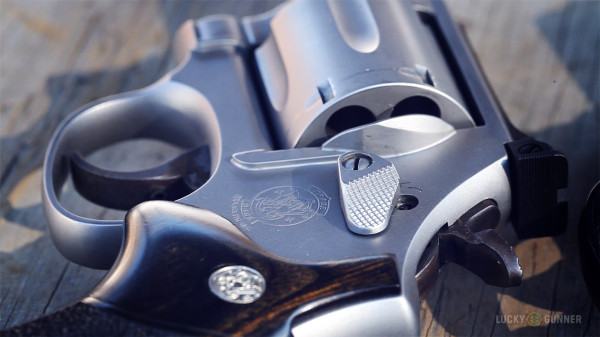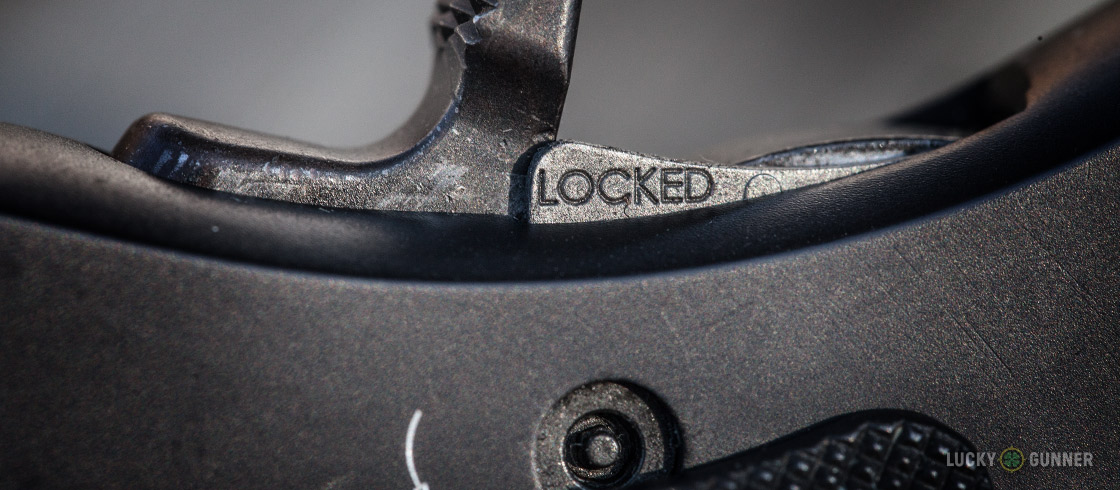Every company makes mistakes. Firearms manufacturers are no stranger to this truth because shooters are arguably among the most vocal hobbyists when it comes to pointing out what they perceive to be mistakes made by the companies that feed their habit. And one of the biggest perceived “mistakes” in the firearms industry in recent memory was the addition of the internal lock on all Smith & Wesson revolvers.
Is the Smith & Wesson Internal Lock a Deal Breaker?
The much-maligned revolver lock appears to be fairly harmless on the surface. Lock-equipped revolvers feature a small key-hole just above the cylinder release latch. By using a key that’s included with the purchase of every new revolver, owners can lock the action of the revolver, supposedly making it “safe” from use by children or other unauthorized persons. The vast majority of S&W revolver owners completely ignore this lock. Many won’t ever know the lock exists unless it’s pointed out to them. That is, of course, unless the lock experiences a malfunction that prevents the revolver from working properly. But more on that later.
Smith & Wesson isn’t the only major gun company to add an internal locking device to their products. They’re not even the only gun company with internal locks known to occasionally fail. Nevertheless, S&W seems to get a lot more criticism for it than any of the other companies. That may have a lot to do with the circumstances under which the revolver lock was introduced.
The Origin of the S&W Lock

The 1990s was an especially difficult decade for firearms makers. The Federal “assault weapons” ban in 1994 was a demoralizing hit to the whole industry, and the political outlook was generally bleak. On top of that, civilian firearms ownership was stagnant and hunting was on the decline. The lifelines keeping many of these companies alive were sales to military and law enforcement. S&W had come out on top as the favorite maker of police-issued revolvers in the 20th century, and enjoyed a strong reputation with decision-makers among the nation’s peace officers as a result. As the switch to semi-auto pistols became inevitable during the 1980s, S&W had plenty of 9mm and .45 ACP offerings for departments to choose from, and the reputation of their revolvers often made S&W pistols a shoe-in against the competition.
Then, along came Glock. The Austrian plastic fantastic hit the scene and crushed S&W’s market share in the law enforcement world. It didn’t help that the perception was S&W’s quality was also slipping at the time, making it almost impossible for them to regain the ground lost to their new competitor. Adding all of that to their political woes threatened to bring an end to the 150-year-old company.
S&W was against the wall and the Clinton White House offered a deal that looked like a way out. But S&W would have to “compromise”, and that involved, among some other ridiculous demands, pledging to include an internal lock in all of their new guns. The agreement was inked in March 2000, and and that’s how the internal revolver lock was born. Though today’s political situation is much different than it was 14 years ago, the S&W revolver locks remain. Similar locking devices have shown up on a few S&W semi-auto pistols and long guns, but almost every new revolver from the company includes the infamous internal lock.
I Heard it On The Internet, So…
To many gun owners, adopting the lock to avoid political trouble was perceived as S&W quite literally selling the soul of the company to the devil. A massive boycott made the situation even worse for S&W, and it took a change of ownership to eventually turn things around.
But in the middle of all of this mess, some civilians were still buying new S&W revolvers, and they found reasons to hate the internal lock that had nothing to do with politics. First, the general consensus is that it was hideous. The big gaping hole right on the side of the frame is not especially subtle. And if that wasn’t enough, there’s the “L” with an arrow printed next to it indicating which direction to turn the lock. For a company whose revolvers are often thought of as quite attractive, this was like tattooing the face of the prom queen.
Of course, that’s just subjective. The revolver is made to shoot, not look at. But that’s why the poo really hit the fan. It wasn’t long before “unconfirmed internet rumors” began to surface about spontaneous malfunctions of the lock. Revolvers owners who had never even taken the key out of the box were having the locks spontaneously engage during routine range sessions. This being the early 2000s, the first online claims were not taken seriously. S&W ignored it, die-hard S&W fanboys ignored it, and even respected figures in the industry chalked it up to rumor-mongering from an already agitated customer-base.
As time wore on, however, it became clear that the rumors were not just rumors. The first clue was that many of the malfunction reports had a key trait in common. They almost all involved the lightweight aluminum alloy or “scandium” framed revolvers firing heavy recoiling ammo. Apparently loading up a 25 oz. snub nose with full house .44 magnums is not just a good way to sprain your wrist, it’s also an effective method of sending serious vibrations through the frame of the gun; enough to cause the little internal lock to shimmy its way into a position its owner did not intend.
Oftentimes, these revolvers weren’t just locking themselves in the sense that the internal lock was activated, they were locked in every sense of the word. No decocking the hammer. No opening the cylinder. The action completely frozen, sometimes even with the hammer cocked and live rounds in the chamber. These broken revolvers sometimes had to be unlocked by a gunsmith, or sent back to S&W.
Eventually, the problem was either witnessed or experienced by well-known “real world” industry professionals, proving that guys like “44GatLuvr” and “FMJ_Sniper” on your favorite gun forum aren’t always full of it. Even with this evidence, S&W still has not officially acknowledged that there is any inherent design flaw with the locks. Rumors continue to fly that S&W plans to “phase out” the locks sometime soon. S&W has even released versions of some J-Frame models that are internal-lock free. But repeatedly, S&W has denied rumors that the lock is being dropped in future revolvers, and as of today, the newest S&W revolver offerings do include the device.
Before You Polish Your Pitchfork

Despite all the damning evidence, the Smith & Wesson internal lock problem is likely not as bad as it appears. In truth, we only have anecdotal evidence that some S&W locks have malfunctioned. We have no real data that would indicate the prevalence of such problems. You can also find anecdotal evidence of exploding Glocks, slides flying off Berettas, and self-firing Remington 700s. Taken individually, none of these reports necessarily indicate any specific trend or “epidemic”. Guns are machines and all machines fail eventually. Some design weaknesses can make certain failures more likely, but it’s really tricky to determine just how likely.
Based on the sporadic reports that can be found online, we can infer a few things about the Smith & Wesson internal revolver locks:
- As mentioned above, they tend to involve light frames and large calibers. There are fewer claims of lock problems with steel-framed revolvers, and very few reported problems with low-pressure cartridges like .38 special and .22 LR.
- Since .38 Spl/.357 Mag revolvers are sold in much greater numbers than the lightweight, big bore revolvers, and the number of reported failures is much smaller, it is likely that the percentage of the popular self-defense revolvers with faulty locks is very small.
- The reported problems often involve revolvers that have had custom work performed on them, or were pre-owned. It’s also a safe assumption that many broken lock claims have come from S&W owners who tinkered with their revolvers but chose to leave that fact out of their “report”.
- S&W internal revolver locks are easy to disable. With simple tools and a little searching online, the lock can be removed (though the unsightly keyhole will remain). There may be liability problems with this for a self-defense revolver but should be fine for a recreational/hunting/competition gun. Also, the fact that S&W now makes some double action only revolvers without the lock might help mitigate the legal risk of disabling a lock yourself (but our lawyer says you shouldn’t take that as legal advice).
- Many of the so-called “internal lock failures” can actually be attributed to user error or some other problem not lock related. Of course, a broken gun is a broken gun, but not all supposed lock failures are genuinely what their owners initially assume they are.
If none of that sounds very reassuring, and you’re still concerned about trusting your life to a lock-equipped S&W revolver, then you have a few options:
- Try to track down one of the few current production S&W models that do not include the lock. The 640 Pro, 642 CT, and M&P340 CT are among the best compact defensive revolvers on the market, and both are available lock-free.
- Buy an older “pre-lock” S&W revolver. Some of the most innovative S&W revolver designs were only first released after the lock was introduced, but many of the iconic classic S&W revolvers were produced in droves for years prior to that sans-lock.
- Buy a Ruger revolver. They are great, and none of them have an internal lock.
- Switch to a semi-auto. What kind of dinosaur carries a revolver these days, anyway? (just kidding!)
Resources
S&W Revolver Lock Failure, Michael Bane. One of the most notable instances of a well-known industry professional “outing” the S&W lock problem. He later admits that having custom work done on the revolver does bring into question the origin of the malfunction.
Internal Gun Locks, Massad Ayoob. Another noted author and firearms instructor weighs in on the lock issue. Mas is not a fan, but admits he has carried a lock-equipped revolver, though only after extensive test-firing. He also includes some good thoughts regarding the wisdom of removing the lock on a self-defense revolver.
The S&W Lock Issue Just Won’t Go Away, Grant Cunningham. Grant is one of the most sought-after revolver-smiths in the country, and has a reputation as a solid shooting instructor as well. He doesn’t recommend his clients carry a lock-equipped gun, but won’t remove them from customer’s guns for liability reasons.
S&W on Wikipedia. The Wiki article has some good info about the corporate happenings of S&W around the time the lock was adopted. The article also mentions that as of 2009, S&W plans to phase out the lock, referencing a Mas Ayoob article from a 2009 issue of American Handgunner. However, the article in question does not exist in any issue of that, or any other publication. In fact, in the 2009 Ayoob blog post we just referenced above, he says just the opposite; that S&W has no plans to remove the lock despite objections from some folks high up in company the food chain. The Wiki reference appears to be a complete hoax.
What’s Your Lock Story?
Have you witnessed or experienced a malfunction related to a S&W revolver lock? Or maybe you carry a lock-equipped gun and have just decided not to worry about the lock. Either way, let us know in the comments below.

